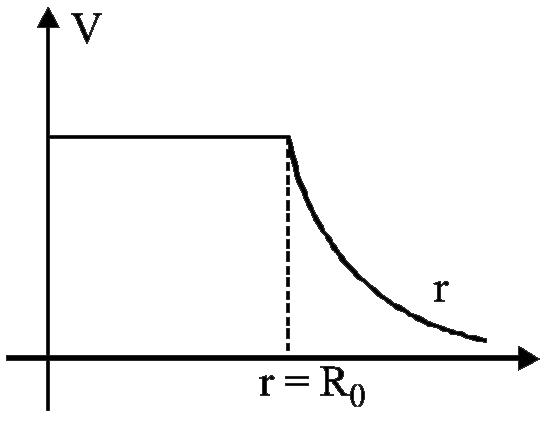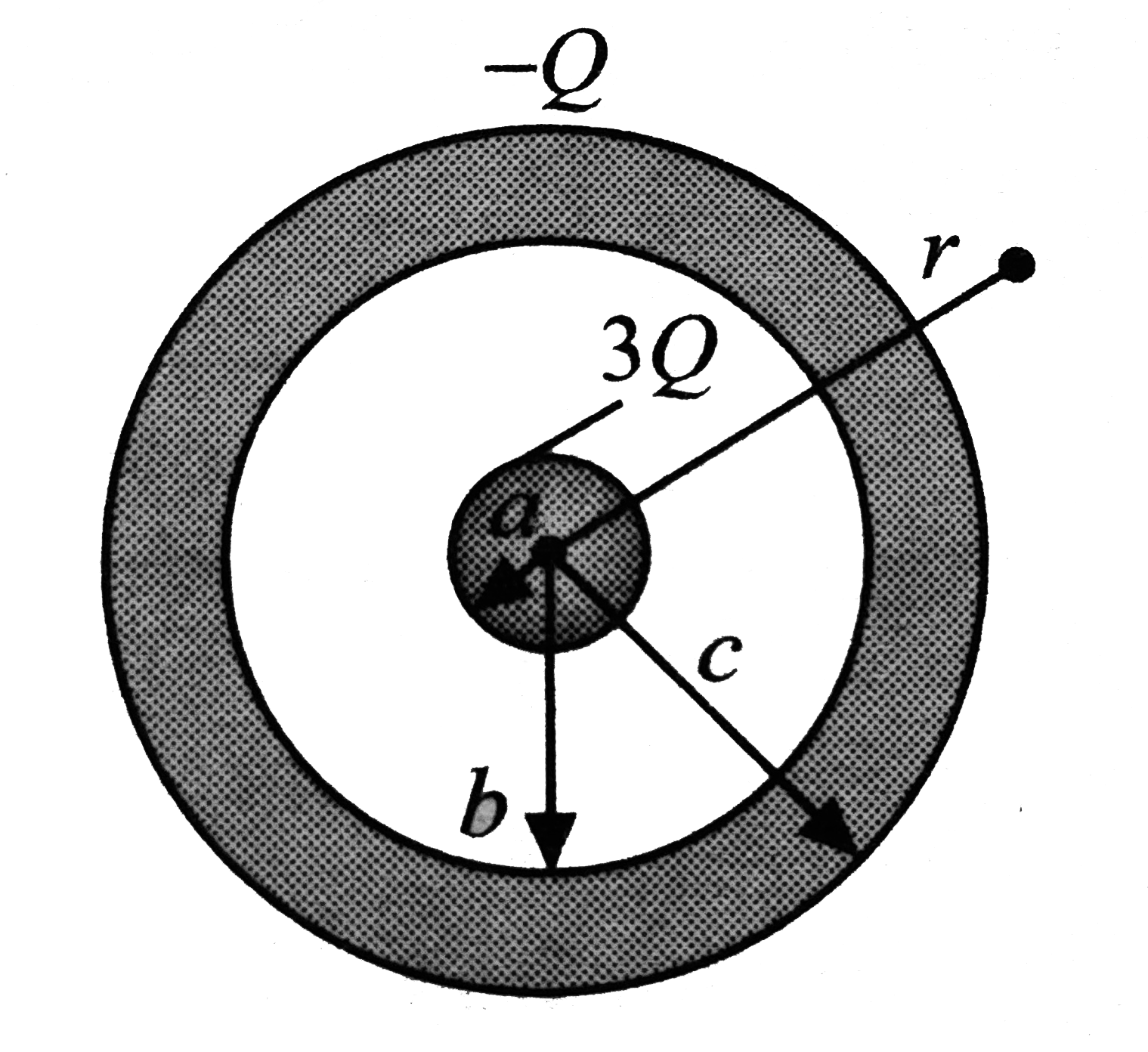In a region of space having a spherical symmetic distribution of charge , the electric flux enclosed by a concentric spherical Gaussion surface, varies with radius
r as ϕ={ϕ0r2R3,r≤R<br>ϕ0, <R where R and ϕ0 are the constants.
E=ϕ04πr2,for r≤R
E=ϕ04πr2,for r>R
E=ϕ0r4πr2,for r≤R
E=ϕ0r4πr2,for r>R
The correct Answer is:b
To solve the problem, we need to analyze the electric flux enclosed by a concentric spherical Gaussian surface in a region with a spherical symmetric distribution of charge. The electric flux is given by the equations for two cases based on the radius r relative to R.
1. Understanding Electric Flux:
The electric flux Φ through a closed surface is given by the equation:
Φ=E⋅A
where E is the electric field and A is the area of the surface. For a sphere of radius r, the area A is:
A=4πr2
2. Case 1: When r≤R:
The electric flux is given by:
Φ=Φ0r2R3
Setting this equal to the expression for flux:
Φ=E⋅4πr2
We can equate the two expressions:
E⋅4πr2=Φ0r2R3
Dividing both sides by 4πr2 (assuming r≠0):
E=Φ04πR3
3. Case 2: When r>R:
The electric flux is constant and equal to Φ0:
Φ=Φ0
Again, using the flux formula:
Φ=E⋅4πr2
Setting these equal gives:
E⋅4πr2=Φ0
Dividing both sides by 4πr2:
E=Φ04πr2
4. Summary of Results:
- For r≤R:
E=Φ04πR3
- For r>R:
E=Φ04πr2
Final Answer:
The electric field E varies with radius r as follows:
- For r≤R: E=Φ04πR3
- For r>R: E=Φ04πr2
The electric flux Φ through a closed surface is given by the equation:
Φ=E⋅A
where E is the electric field and A is the area of the surface. For a sphere of radius r, the area A is:
A=4πr2
The electric flux is given by:
Φ=Φ0r2R3
Setting this equal to the expression for flux:
Φ=E⋅4πr2
We can equate the two expressions:
E⋅4πr2=Φ0r2R3
Dividing both sides by 4πr2 (assuming r≠0):
E=Φ04πR3
The electric flux is constant and equal to Φ0:
Φ=Φ0
Again, using the flux formula:
Φ=E⋅4πr2
Setting these equal gives:
E⋅4πr2=Φ0
Dividing both sides by 4πr2:
E=Φ04πr2
- For r≤R:
E=Φ04πR3
- For r>R:
E=Φ04πr2
The electric field E varies with radius r as follows:
- For r≤R: E=Φ04πR3
- For r>R: E=Φ04πr2
Topper's Solved these Questions
- ELECTRIC FLUX AND GAUSS LAWBOOK - CENGAGE PHYSICS ENGLISHCHAPTER - ELECTRIC FLUX AND GAUSS LAWEXERCISE - Subjective type
7 Videos
- ELECTRIC CURRENT AND CIRCUITBOOK - CENGAGE PHYSICS ENGLISHCHAPTER - ELECTRIC CURRENT AND CIRCUITEXERCISE - Interger
8 Videos
- ELECTRIC POTENTIALBOOK - CENGAGE PHYSICS ENGLISHCHAPTER - ELECTRIC POTENTIALEXERCISE - DPP 3.5
15 Videos
Similar Questions
In a region of space having a spherically symmetric distribution of charge, the electric flux enclosed by a concentric spherical Gaussian surface, varies with radius r as
ϕ=ϕ0r3R3 for r≤R
ϕ=ϕ0 for r > R
where R and ϕ0 are constants.
The volume charge density in the region is given as
View SolutionA spherical shell of radius R has a uniformly distributed charge ,then electric field varies as
View SolutionA charge Q is enclosed by a Gaussian spherical surface of radius R. If the radius is doubled, then the outward electric flux will
View SolutionThe capacitance of two concentric spherical shells of radii R1 and R2(R2>R1) is
View SolutionThe current density in a wire of radius a varies with radial distance r as J=J0r2a, where J0 is a constant. Choose the incorrect statement.
View SolutionFor spherical symmetrical charge distribution, variation of electric potential with distance from centre is given in diagram Given that : V=q4πε0R0 for r≤R0andV=q4πε0r for r≥R0
Then which option (s) are correct :
(1) Total charge within 2R0 is q
(2) Total electrosstatic energy for r≤R0 is non-zero
(3) At r=R0 electric field is discontinuous
(4) There will be no charge anywhere except at r<R0

View SolutionIf the electric flux entering and leaving an enclosed surface respectively is ϕ1 and ϕ2, the electric charge inside the surface will be
View SolutionA solid insulating sphere of radius a carries a net positive charge 3Q, uniformly distributed throughout its volume. Concentric with this sphere is a conducting spherical shell with inner radius b and outer radius c and having a net charge -Q, as shown in figure

a. Consider a spherical Gaussian surface of radius rgtc, the net charge enclosed by this surface is .............
b. The direction of the electric field rgtc is .............
c. The electric field at rgtc is ............... .
d. The electric field in the region with radius r, which cgtrgtb, is ...............
e. Consider a spherical Gaussian surface of radius r, where c>r>b, the net charge enclosed by this surface is ................ .
f. Consider a spherical Gaussian surface of radius r, whereb>r>a, the net charge enclosed by this surface is ................. .
g. The electric field in the region b>r>a is ................ .
h. Consider a spherical Gaussian surface of radius r<a. Find an expression for the net charge Q(r) enclosed by this surface as a function of r. Note that the charge inside the surface is less than 3Q.
i. The electric field in the region r<a is ................. .
j. The charge on the inner surface of the conducting shell is .......... .
k. The charge on the outer surface of the conducting shell is .............. .
l. Make a plot of the magnitude of the electric field versus r.
View SolutionA spherical capacitor consists of two concentric spherical conductors, held in position by suitable insulating supports. Show that the capacitance of this spherical capacitor is given by C=4π∈0r1r2r1−r2,
Where r1andr2 are radial of outer and inner spheres respectively.
View SolutionDefine electric flux. Write its SI unit. A charge q is enclosed by a spherical surface of radius R. If the radius is reduced to half, how would the electric flux through the surface change ?
View Solution
